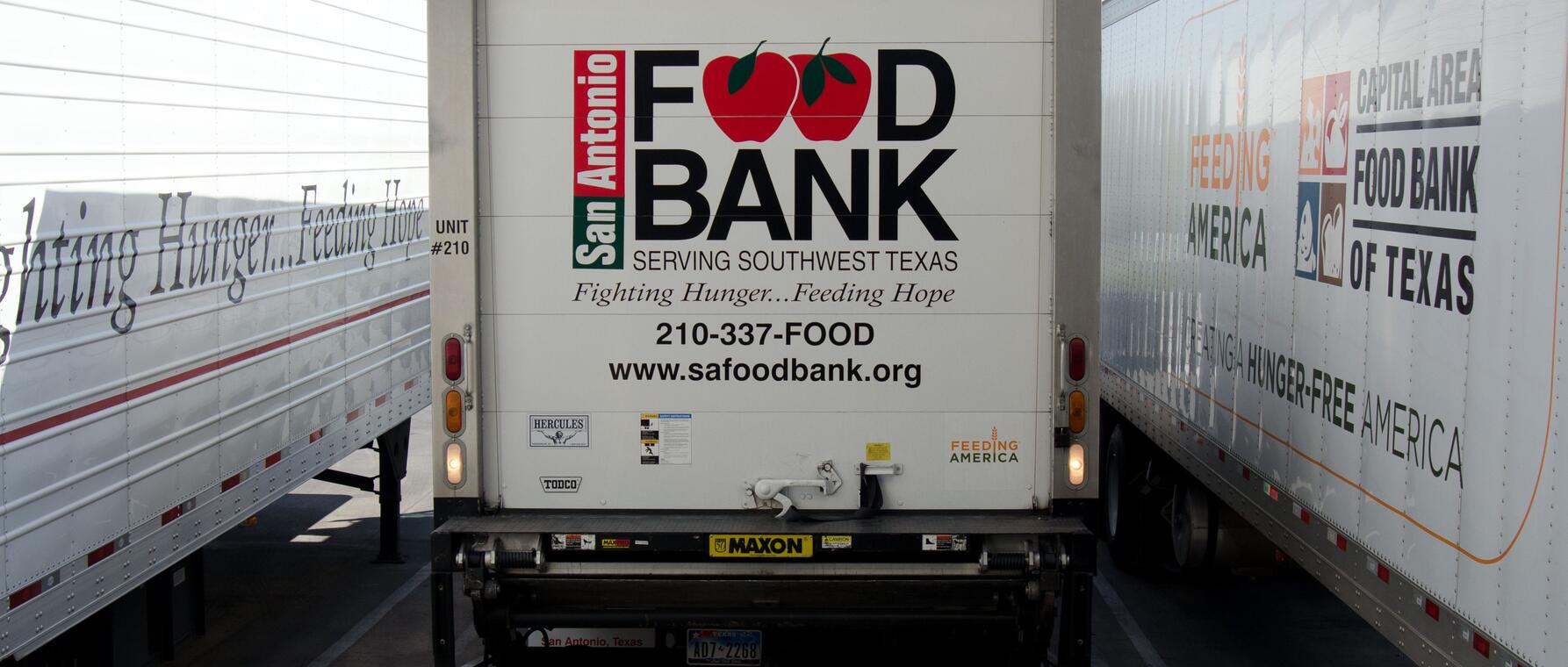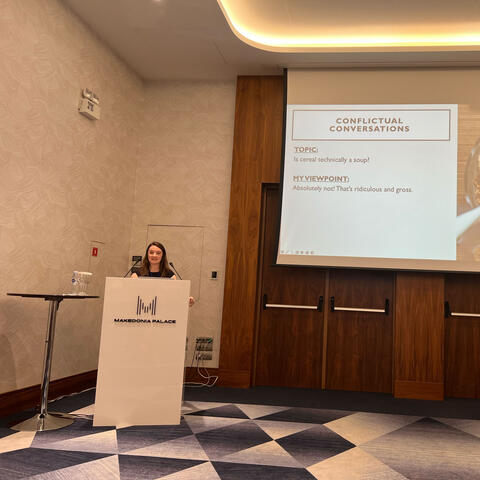How SNAP Cuts Will Impact American Communities
Scholar warns of increases in food insecurity, threats to public health

President Trump’s 2025 domestic policy bill would significantly reduce federal spending on the Supplemental Nutrition Assistance Program (SNAP) over the next decade. The bill also shifts some of the cost of benefits to states and tightens and expands work requirements—for instance, to include adults aged 55 to 64 (up from the previous cutoff of 49) and parents with children aged 14 and older.
Leah Gose, PhD ’23, provost postdoctoral fellow and assistant professor of sociology at the University of Southern California, studies the problem of hunger in the United States and how local organizations are responding. In the following interview, Gose, the author of a forthcoming book tentatively titled Feeding Americans: How Food Pantries Fuel Civic Life in the USA, says that the bill’s cuts will have a devastating impact on food-insecure families and the communities in which they live.
SNAP has been linked to a range of positive outcomes, from better health to reduced food insecurity. Can you explain the impact the program has on people and communities?

Absolutely. SNAP plays a crucial role in the lives of millions of Americans. On average, about 41 million people—or roughly 22 million households—use SNAP each year. That’s approximately 12 percent of the U.S. population. And there’s significant overlap between SNAP recipients and those who receive other forms of support, like Medicaid; about 30 million people are enrolled in both programs.
SNAP’s impact goes far beyond just putting food on the table. The USDA estimates that even in a weak economy, every dollar of SNAP spending generates about $1.50 in economic activity. That means the program boosts not only household budgets but also the broader communities in which recipients live. It reduces food insecurity, yes, but it also helps people avoid impossible choices—like whether to buy groceries or fill a prescription. For low-income families, being able to afford food often determines whether they can afford medicine. This bill will force people to make life or death choices. It’s that simple—and that serious.
Do we know how much SNAP actually reduces food insecurity?
Feeding America, the largest national nonprofit addressing hunger, supports about 200 food banks and 60,000 partner agencies across the country. They see SNAP as an essential and effective part of the fight against hunger. For instance, their affiliated food banks have been instrumental in getting eligible folks enrolled in SNAP. For the Atlanta Community Food Bank, that meant processing over 12,000 applications in 2024.
Research shows that about 45 percent of food pantry users are already on SNAP. So for many households, SNAP isn’t a standalone solution—it’s one link in a chain. People might use SNAP, formerly food stamps, visit pantries or soup kitchens, and rely on community networks just to stay afloat. SNAP keeps people from falling off a cliff. If you cut it, you’re not trimming fat—you’re breaking a vital link in that chain.
Right now, the average SNAP benefit is about $188 a month—or roughly $6 a day . . . Reducing benefits further or increasing barriers to access will force people to go hungry.
Where are we now in terms of national food insecurity?
Unfortunately, we’re moving in the wrong direction. In 2021, Feeding America estimated that 50 million people were food insecure during the pandemic due to job losses and economic instability—a huge jump from 2019 when rates were trending down after the Great Recession. But then we saw a big drop in 2021 and 2022 because of pandemic-era expansions to SNAP. For a time, rates of food insecurity almost dipped into the single digits nationally.
Now we’re back up. Estimates from 2023 put the national average at 13.5 percent. Only one state—North Dakota—has a food insecurity rate below 10 percent. And remember, these numbers are always a little behind because they’re based on survey data from the previous year’s Current Population Survey’s Food Security Supplement. But the trend is clear: food insecurity is rising because the cost of living is rising. SNAP helps, but it’s already not enough to counteract the entire tide.
What’s the projected impact of the proposed SNAP cuts?
The impact would be devastating. The most immediate outcome would lead to about three-quarters of a million additional people experiencing food insecurity in the next year. And that’s just the beginning. Over the long term, as funding shrinks and states are asked to pick up more of the cost, that number will skyrocket.
Right now, the average SNAP benefit is about $188 a month—or roughly $6 a day. That doesn’t mean everyone gets that amount; it varies by income and household make-up. Four out of five SNAP recipients say their current benefits aren’t enough to cover their food needs. So we’re already starting from a place of insufficiency. Reducing benefits further or increasing barriers to access will force people to go hungry.
When you reduce SNAP and Medicaid at the same time—which this bill does—you force people to choose between food and medicine. You push them closer to crisis, to chronic illness, to homelessness. And it doesn’t just hurt individuals. It harms entire communities. SNAP dollars fuel local economies. When those dollars disappear, it affects corner stores, farmers’ markets—even places like Walmart. It’s short-sighted and cruel.
Can you explain what the Thrifty Food Plan is and why it matters?
The Thrifty Food Plan (TFP) is the USDA’s model for the cost of a minimal, nutritious diet. SNAP benefit amounts are based on this plan. Every few years, the TFP is adjusted for inflation and changes in food prices, which usually leads to modest increases in benefits. In 2021, it was reevaluated to include estimates for a more realistic 21st-century diet, raising benefits modestly.
The proposed legislation includes a provision to cap the TFP going forward, meaning that even as food costs rise, SNAP benefits won’t increase to match them. That erodes the value of every SNAP dollar. It’s like saying, “We’ll help you pay for groceries—but not if they get more expensive.” That’s a recipe for disaster.
The bill also shifts more of the cost to states. What will that mean in practice?
It means more red tape, more administrative strain, and fewer benefits. States already pay for some administrative costs, but the federal government currently covers 100 percent of the actual benefits. This bill would change that. If states have a payment error rate over a certain threshold, they’d have to start footing part of the bill for benefits too. That’s on top of their administrative costs.
What happens then? States will have incentives to do less. To avoid costs, they’ll make eligibility stricter, reduce services, or drop programs altogether. We’re already seeing this. Texas recently opted out of summer EBT (electronic benefits transfer), which provides food assistance to children during school breaks, citing increased burdens from administrative costs. This is a preview of a race to the bottom, where the most vulnerable people lose out.
According to Feeding America, 86 percent of adults on SNAP earned a legal income in the last year. The majority of SNAP recipients are already working, and they’re working low-wage jobs that don’t pay enough to meet basic needs.
Supporters of the bill say it promotes accountability and targets aid to those truly in need. Is that accurate?
The cuts won’t refocus benefits on children or the elderly. They’ll reduce benefits across the board. There’s no provision to take money saved from “able-bodied adults” and give it to someone else. The program will just shrink.
Also, error rates are being used as a political cudgel. SNAP payment error rates measure unintentional errors only—things like changes in an applicant’s income that weren’t reported in time. States already submit corrective action plans (CAPs) to address these and must reimburse the federal government for overpayments. So, the system is working as designed, but under this bill, error rates would be used to punish states financially. It’s a bad-faith argument.
What about the claim that tougher work requirements promote self-sufficiency?
According to Feeding America, 86 percent of adults on SNAP earned a legal income in the last year. The majority of SNAP recipients are already working, and they’re working low-wage jobs that don’t pay enough to meet basic needs. The minimum wage in many states is still $7.25 an hour—you can’t rent an apartment on that, let alone pay for groceries.
Expanding work requirements means more people will have to jump through hoops to prove they’re working. That increases the paperwork and time burden for them and for the state. And some people—like caregivers or those with undiagnosed disabilities—just won’t be able to keep up. They’ll fall off the rolls, even though they still need help. That’s the point of the bill: to reduce participation, not increase self-sufficiency.
What role can food pantries play in addressing increased need?
Food pantries and other local organizations will continue to work tirelessly to get food to people who need it, and that work will never be enough Feeding America provided six billion pounds of food in 2024, and the food insecurity rate is still over 10 percent. If SNAP is cut, they estimate they’ll need to provide six to nine billion more meals each year to fill the gap. There’s no way they can do that. Pantries are already operating at or over capacity—and have been since the Great Recession.
We’re going to see more people at food banks getting less food. I volunteer at a pantry in Silver Lake, and the directors I work with are already worried. They don’t have enough food, labor, or money to handle what’s coming. And they shouldn’t have to. Pantries were never meant to replace federal food assistance.
What can people do to help?
Get involved. Volunteer at your local food pantry or soup kitchen. Not only will you help meet urgent needs, but you’ll also learn a lot about how policies affect real people—your neighbors! Pantries are civic spaces—they’re where people come together, learn about the system, and start to change it. And they will only need more support moving forward.
Get the Latest Updates
Join Our Newsletter
Subscribe to Colloquy Podcast
Simplecast





